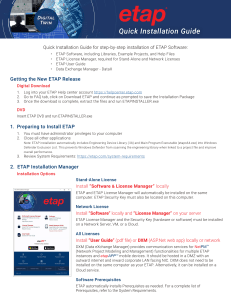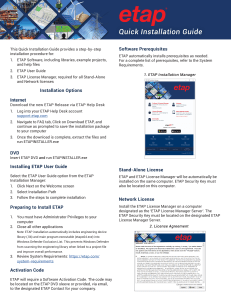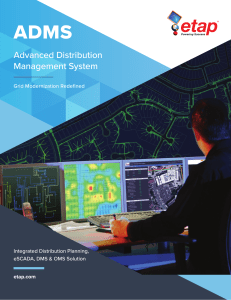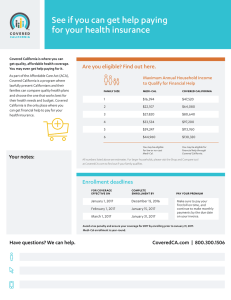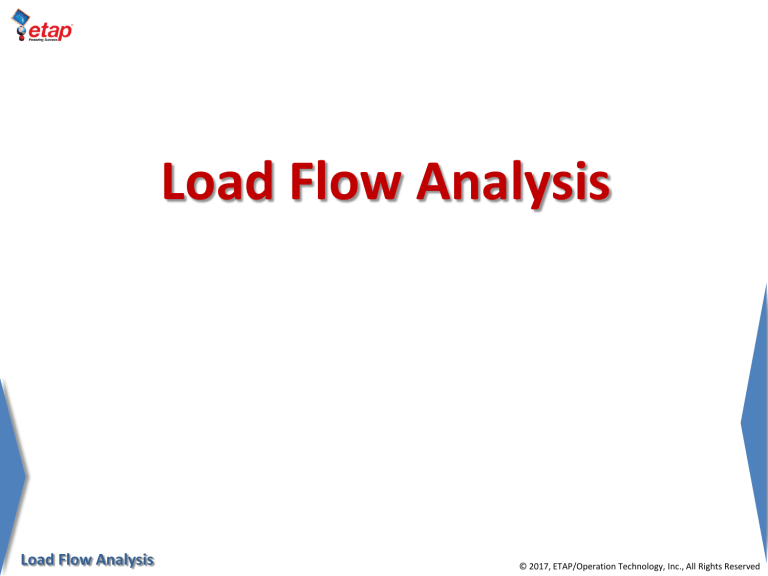
Load Flow Analysis Load Flow Analysis © 2017, ETAP/Operation Technology, Inc., All Rights Reserved Load Flow Overview Overview Topics Basic Concepts Methodology 3Ph & 1Ph Power Goals Steps Non-Linear Objectives PF Iterative Methods Capabilities Per Unit Loading & Generation Panels Load & Gen Categories Study Case Main & Subs & Toolbars Connections Generation Global Adjustments Schedule Operation Modes Data Requirements Lumped Load Load Invertor, Charger, Types UPS Decoupled OLV Display Generator Systems DataBlock, … Limits Exercise 1&2 IEEE Example Example Run Studies Panel Advanced Topics Summary Convergence OPF 3-Phase Alerts 2-Phase 1-Phase Reports Create Wizard Result Analyzer Exercise 3 Blue – PowerPoint Load Flow Analysis Orange - ETAP © 2017, ETAP/Operation Technology, Inc., All Rights Reserved Overview • • • • • • • • Mother of all Studies Load Flow Analysis is an Engineering Art The Art of duplicating and understanding the steady-sate behavior of Power Systems First studies to be done to validate the project model Last studies to be done to validate other studies Has contradictory objectives with SC & TS studies Need to consider past, present & future conditions Need to consider all possible operating conditions Compare limits & duties for the correct operation of the power systems apparatus Load Flow Analysis © 2017, ETAP/Operation Technology, Inc., All Rights Reserved Overview Objectives • To Protect the System Against: – Electrical Limits • Over/Under Voltage conditions • Over Load conditions • Voltage and Current Limits – Mechanical • Tension & Stress Levels • Life Time – Thermal • Steady-State Temperature Limits • Emergency Temperature Limits Load Flow Analysis © 2017, ETAP/Operation Technology, Inc., All Rights Reserved Overview Objectives • Steady-State Operating Conditions Load Flow Analysis Voltage Profile Power Flows Current Flows Power Factors Voltage Drops Generator’s Mvar Demand (Qmax & Qmin) Generator’s MW Demand Total Generation & Demand MW & Mvar Losses © 2017, ETAP/Operation Technology, Inc., All Rights Reserved Overview Capabilities Handel any kind of Integrated Network No Limitations for the followings Connectivity / Subsystems DC, AC (1P-1W, 1P-2W, 2P-2W, 2P-3W, 3P-3W, 3P-4W Nominal Voltage Frequency Phase Connection Bus Number – 1,000,000+ tested Load Flow Analysis © 2017, ETAP/Operation Technology, Inc., All Rights Reserved Basic Concept • Power in Balanced 3-Phase Systems S 1 V LN I * S 3 3 S 1 3 V LL I * P jQ Inductive loads have lagging Power Factors. Capacitive loads have leading Power Factors. Lagging Power Factor Load Flow Analysis Leading Power Factor Current and Voltage © 2017, ETAP/Operation Technology, Inc., All Rights Reserved Load Flow Concept • Leading & Lagging Power Factors Leading PF: Lagging PF: P+jQ , -P-jQ P-jQ, -P+jQ Gen1 Bus3 4997.8 -j270.9 Cable1 6 % 99.5 Bus1 796.9 j330.5 Mtr1 -697.8 j289.4 Mtr3 Load Flow Analysis 796.9 j330.5 Syn1 Syn2 796.9 -j330.5 848.5 j525.9 LUMP1 848.5 -j525.9 LUMP2 793 j594.8 Load1 793 -j594.8 Load2 j892.1 CAP1 © 2017, ETAP/Operation Technology, Inc., All Rights Reserved Load Flow Concept • Leading & Lagging Power Factors Current (amp) direction is based on the value of P (kW). Leading Power Factor are displayed as a negative value. Gen1 Bus3 209.4 -99.9% Cable1 6 % 99.5 209.4 -99.9% Bus1 36.3 92.4% Mtr1 -31.7 -92.4% Mtr3 Load Flow Analysis 36.3 92.4% Syn1 36.3 -92.4% Syn2 41.9 85% LUMP1 41.9 -85% LUMP2 41.7 80% Load1 41.7 -80% Load2 37.5 0% CAP1 © 2017, ETAP/Operation Technology, Inc., All Rights Reserved Load Flow Concept • 3-Phase Per Unit System Three phase power equation S 3VI V 3 ZI Base calculations IB kVA B 3kVB (kVB ) 2 ZB MVA B Per Unit calculations I pu Zpu Load Flow Analysis I actual IB Vpu Zactual ZB Spu Vactual VB Sactual SB Z n pu V Z V o pu o B n B 2 S Bn o SB © 2017, ETAP/Operation Technology, Inc., All Rights Reserved Load Flow Concept • Elimination of Transformer Turn Ratio: To determine base voltage: kVB1 N1 kVB2 N2 Bus 1 kVB1 Bus 2 kVB2 Impedance of transformer in per unit: X pu Load Flow Analysis X Z pu R 2 X 1 R R pu Cabl x pu X R © 2017, ETAP/Operation Technology, Inc., All Rights Reserved Load Flow Concept Base for per unit or % values in ETAP Machines Z Rated kVA and kV ANSI Transformers Z Rated Output kVA and kV IEC Transformers Z Rated Input kVA and kV Base Voltage Bus Nominal kV % Loading Reports Loads Rated kVA Transformers Max kVA Lines & Cables Allowable (Derated/U-D) Amp Load Flow Analysis © 2017, ETAP/Operation Technology, Inc., All Rights Reserved Load Flow Concept • Example: Base voltage calculation across a transformer in ETAP: Branch impedances in LF report are in percentage Turn ratio: N1/N2 = 3.31 X/R = 12.14 Load Flow Analysis © 2017, ETAP/Operation Technology, Inc., All Rights Reserved Load Flow Concept • Example (cont’d): X pu 0.065 (12 .14 ) 1 (12 .14 ) 2 R pu 0.06478 0.06478 0.005336 12 .14 Impedance conversion to 100 MVA base “n” stands for new & “O” stands for old values Z n pu o o VB Z pu n VB 2 S Bn 13.8 o (5.33 10 3 j 0.06478) S 13 . 5 B 2 100 (0.1115 j1.3538) 5 %Z 100 Zpu 11 .15 j135 .38 The base voltage of the branch impedance (Z1) determined by transformer turn ratio kVutility 13 .5 VB 4.0695 N 1 3.31 N 2 Load Flow Analysis VB2 (4.0695 ) 2 ZB 0.165608 MVA 100 © 2017, ETAP/Operation Technology, Inc., All Rights Reserved Load Flow Concept • Example (cont’d) : Z pu Zactual (0.1 j1) (0.6038 j6.0382 ) ZB 0.1656 %Z 100 Zpu 60 .38 j603 .8 Load flow report generated by ETAP for branches: Load Flow Analysis © 2017, ETAP/Operation Technology, Inc., All Rights Reserved Load Flow Concept Decoupled Systems: V 1 V1 1 V 2 V2 2 S V I P jQ V V2 1 Sin(1 2 ) X 2 V1 V2 V2 j Cos (1 2 ) X X V1 V2 P Sin(1 2 ) X 2 V1 V2 V2 Q Cos(1 2 ) X X Load Flow Analysis © 2017, ETAP/Operation Technology, Inc., All Rights Reserved Load Flow Concept Decoupled Systems: Gen1 U1 1.7 j1.054 Bus1 1.7 j1.054 % 100 0 de g LUMP1 1.7 j1.054 1.707 j1.058 Gen2 % 101 3.26 j78.735 1.554 j77.677 0 de g Bus4 1.7 j1.054 Gen3 U3 % 100 1339.5 j91.184 1.7 j1.054 Load Flow Analysis 0 de g LUMP4 T2 LUMP5 % 100 0.162 -j75.854 LUMP3 Bus5 0 de g LUMP2 T1 U2 Bus3 Bus2 % 100 1.7 j1.054 1337.8 j90.13 10 d eg T3 Bus6 % 100 1331.5 -j144.6 1.7 j1.054 0 de g LUMP6 © 2017, ETAP/Operation Technology, Inc., All Rights Reserved Load Flow Concept • Power transfer between two buses in per unit 1 ( V E) X ( V E) X sin cos Power Flow 1 0 2 V X 1 2 2 0 Real Power Flow Reactive Power Flow Load Flow Analysis © 2017, ETAP/Operation Technology, Inc., All Rights Reserved Methodology Goals Steps Non-Linear Solution Solution Methods Requirements Load Types PV, PQ Elements Load Flow Analysis © 2017, ETAP/Operation Technology, Inc., All Rights Reserved Goal Methodology A healthy operation under different conditions *** Size Equipments & Determine Parameters *** Cable Lines Capacitor Transformer MVA Rating Transformer Tap Setting & Limits Current Limiting Reactor Ratings MCC & Switchgear Current Ratings Generator Operating Mode (Isochronous / Droop) Generator’s Mvar Demand Transmission, Distribution & Utilization kV Load Flow Analysis © 2017, ETAP/Operation Technology, Inc., All Rights Reserved Methodology • Verify operation conditions within limits Bus Voltages are Within Acceptable Limits Voltages are Within Rated Insulation Limits of Equipment Power & Current Flows Do Not Exceed the Maximum Ratings Acceptable System MW & Mvar Losses Circulating Mvar Flows are Eliminated Steady State Stability Limits • Validation of data in steady state condition Comparison of real time metered data with load flow results Load Flow Analysis © 2017, ETAP/Operation Technology, Inc., All Rights Reserved Methodology • Load Flow Problem Given: Power consumption at all buses Branch impedances in the network Network Topology (Configuration) Generation and load VAriation Output: Voltage magnitude and angle at all buses Power flows on all the branches including power factors Losses on all branches Load Flow Analysis © 2017, ETAP/Operation Technology, Inc., All Rights Reserved Steps in a Project Methodology 1. Understand the Scope of the Project and its Objectives 2. Obtain existing equipment data, one-lines, study reports, plots, recorded data, etc. 3. Convert project files to ETAP via DataX 4. LF Data collection: NPs, settings, positions, etc. 5. Model Validation using network & operating info 6. Verifying all allowable limits, V, A, kVA, kW, time, etc. 7. Run 100s of studies 8. Verify acceptance using the LF Analyzer 9. Create Wizard for top most 10-50 studies that show verification of the worst operating requirements. 10. Create the study report, using CR, OLV, PDF, Excel, … Load Flow Analysis © 2017, ETAP/Operation Technology, Inc., All Rights Reserved Methodology Non-Linear System • Calculation Process Iterative Calculation Assume Load Voltage “VR” (Initial Conditions) Calculate the Current “I” Based on Current Calculate Voltage Drop “Vd” Assume VR Calc: I = Sload / VR Calc: Vd = I * Z Re-Calc VR = Vs - Vd Re-Calculate Load Voltage “VR” Re-use “VR” until results are within the specified precision Load Flow Analysis © 2017, ETAP/Operation Technology, Inc., All Rights Reserved Methodology • Load Flow Calculation Methods Newton-Raphson Fast in speed, but high requirement on initial values First order derivative is used to speed up calculation Load Flow Analysis © 2017, ETAP/Operation Technology, Inc., All Rights Reserved Methodology • Load Flow Calculation Methods Adaptive Newton-Raphson Fast in speed, but high requirement on initial values First order derivative is used to speed up calculation Load Flow Analysis © 2017, ETAP/Operation Technology, Inc., All Rights Reserved Methodology • Load Flow Calculation Methods Accelerated Gauss-Seidel Method Low Requirements on initial values Slow in speed Load Flow Analysis © 2017, ETAP/Operation Technology, Inc., All Rights Reserved Methodology • Load Flow Calculation Methods Fast-Decoupled Method Two sets of iteration equations: real power – voltage angle, reactive power – voltage magnitude in speed, but high requirement on initial values Fast in speed, but low in solution precision Better for radial systems and systems with long lines Load Flow Analysis © 2017, ETAP/Operation Technology, Inc., All Rights Reserved Methodology • Possible Convergence Issues Negative Impedance Zero or Very Small Impedance Widely Different Branch Impedance Values Long Radial System Configurations Improper Initial Bus Voltage Values Imbalance of demand/supply in the system Load Flow Analysis © 2017, ETAP/Operation Technology, Inc., All Rights Reserved Load Flow Requirements • ETAP load flow required data General Equipment Data Element ID Nominal / Rated kV Load Flow Analysis © 2017, ETAP/Operation Technology, Inc., All Rights Reserved Load Flow Requirements • ETAP load flow required data Bus: %V and Angle Load Diversity Factor Load Flow Analysis © 2017, ETAP/Operation Technology, Inc., All Rights Reserved Load Flow Requirements • ETAP load flow required data Branch in general: Branch Z, R, X, or X/R values and units, tolerance, and temperature, if applicable Cable and transmission line, length, and unit Load Flow Analysis © 2017, ETAP/Operation Technology, Inc., All Rights Reserved Load Flow Requirements • ETAP load flow required data Branch in general: Branch Z, R, X, or X/R values and units, tolerance, and temperature, if applicable Transformer rated kV and kVA/MVA, tap, and LTC settings Load Flow Analysis © 2017, ETAP/Operation Technology, Inc., All Rights Reserved Load Flow Requirements • ETAP load flow required data Branch in general: Branch Z, R, X, or X/R values and units, tolerance, and temperature, if applicable Impedance element base kV and base kVA/MVA Load Flow Analysis © 2017, ETAP/Operation Technology, Inc., All Rights Reserved Exercise Example-B1 Load Flow Analysis © 2017, ETAP/Operation Technology, Inc., All Rights Reserved Exercise Purpose & Description • The purpose of this exercise is to introduce the equipment editor fields for the load flow calculation. • The Load Flow required data for different elements are introduced. Load Flow Analysis © 2017, ETAP/Operation Technology, Inc., All Rights Reserved Methodology Load Type Summary Load Flow Analysis © 2017, ETAP/Operation Technology, Inc., All Rights Reserved Load Types in Power System Load Flow Analysis © 2017, ETAP/Operation Technology, Inc., All Rights Reserved Load Types in Power System Load Flow Analysis © 2017, ETAP/Operation Technology, Inc., All Rights Reserved Load Modeling in ETAP • Constant Power (kVA) Loads • Motor loads, Constant Power output regardless of voltage variations - P = T * Rotor Speed Induction Motor Synchronous Motors Lumped Load – Option • Combination of constant power, current, & impedance loads with frequency dependencies Load Flow Analysis © 2017, ETAP/Operation Technology, Inc., All Rights Reserved Load Modeling in ETAP • Example: Motor Nameplate Calculation kWRated HP 0.7457 PF Eff PF Eff kVARated FLA3 3 kV kVARated FLA1 kV kVARated Mtr 2 : PF 90 %, EFF 85 % 200 0.7457 194 .95 0.9 0.85 194 .95 234 .48 3 0.48 194 .95 406 .14 0.48 k VARated FLA3 FLA1 Load Flow Analysis © 2017, ETAP/Operation Technology, Inc., All Rights Reserved Load Modeling in ETAP • Constant Impedance Loads Static Load Motor Operated Valve Lumped Load Capacitor Harmonic Filter • Power & Voltage relation: P V 2 • In Load Flow Harmonic Filters may be used as capacitive loads for Power Factor Correction. • MOVs are modeled as constant impedance loads because of their operating characteristics. Load Flow Analysis © 1996-2008 Operation Technology, Inc. – Workshop Notes: Load Flow Analysis Slide 44 © 2017, ETAP/Operation Technology, Inc., All Rights Reserved Load Modeling in ETAP • Example (Cont’d): Load Calculation k VA ( k W ) 2 ( k Var) 2 kW k VA k VA ( 3 kV) k VA kV PF I 3 I1 Load1 : PF 90 %, kVA 280 kW 59 .6 0.9 252 kVar (59 .6) 2 (53 .64 ) 2 122 59 .6 336 .8 3 0.48 59 .6 I1 194 .68 0.48 Load Flow Analysis I 3 © 2017, ETAP/Operation Technology, Inc., All Rights Reserved Load Modeling in ETAP • Constant Current Loads Current remains constant regardless of voltage variations DC Constant current loads are used to test Battery discharge capacity AC constant current loads may be used to test UPS systems performance DC Constant Current Loads may be specified in ETAP by defining Load Duty Cycles Load Flow Analysis © 2017, ETAP/Operation Technology, Inc., All Rights Reserved Load Modeling in ETAP • Constant Current Loads (Cont’d): Load Flow Analysis © 2017, ETAP/Operation Technology, Inc., All Rights Reserved Exercise Example-B2 Load Flow Analysis © 2017, ETAP/Operation Technology, Inc., All Rights Reserved Exercise • • • • Purpose & Description The purpose of this exercise is to introduce features such as alert views, load flow reports and load flow analyzer. Check voltage and loading conditions. Voltage regulation Element sizing Load Flow Analysis © 2017, ETAP/Operation Technology, Inc., All Rights Reserved Loading & Generation Overview Generator Operation Modes Renewable Energy Motor Operation Generic Loads Invertors & Chargers UPS Equipment Limits Load Flow Analysis © 2017, ETAP/Operation Technology, Inc., All Rights Reserved Generator Operation Modes • Synchronous Generator & Control System Load Flow Analysis © 2017, ETAP/Operation Technology, Inc., All Rights Reserved Generator Operation Modes • Governor Operating Modes Isochronous: This governor setting allows the generator’s power output to be adjusted based on the system demand Frequency (speed) is constant per system’s nominal frequency Droop: This governor setting allows the generator to be Base Loaded, meaning that the MW output is fixed at Load Flow Analysis © 2017, ETAP/Operation Technology, Inc., All Rights Reserved Generator Operation Modes • Generator Excitation System AVR: automatic voltage regulation Feedback voltage from generator terminal Comparison of feedback to reference voltage in AVR unit Fixed: fixed excitation (no AVR) Load Flow Analysis © 2017, ETAP/Operation Technology, Inc., All Rights Reserved Generator Operation Modes • Isochronous Mode Load Flow Analysis © 2017, ETAP/Operation Technology, Inc., All Rights Reserved Generator Operation Modes • Droop Mode Loading @60Hz Governor Set Point 0% A 25% B 50% C 75% D 100% E Load Flow Analysis © 2017, ETAP/Operation Technology, Inc., All Rights Reserved Generator Operation Modes • Droop Mode – Equal Settings 60Hz and constant loading of 400MW Equal load sharing G1 = G2 = 200MW • Droop Mode – Unequal Settings Increase G1 governor setting by 0.3Hz G2 governor setting must decrease by 0.3Hz Unequal load sharing G1 = 150 MW; G2 = 250MW Load Flow Analysis © 2017, ETAP/Operation Technology, Inc., All Rights Reserved Generator Operation Modes • Unequal Speed Droops Initial operating frequency at 60Hz Initial loading G1 = G2 = 350MW • Effect of load variations Total increase of load by 350MW Frequency drop by 0.5Hz Unequal load sharing G1 = 600MW; G2 = 450MW Load Flow Analysis © 2017, ETAP/Operation Technology, Inc., All Rights Reserved Generator Modes in ETAP • Generator/Power Grid operating modes used in LF calculation Swing Mode Governor in Isochronous mode Automatic Voltage Regulator Voltage Control Governor in Droop Mode Automatic Voltage Regulator Mvar Control Governor in Droop Mode Fixed Field Excitation (no AVR action) PF Control Governor in Droop Mode AVR Adjusts to Power Factor Setting Load Flow Analysis © 2017, ETAP/Operation Technology, Inc., All Rights Reserved Generator Modes in ETAP • If in Voltage Control Mode, the limits of P & Q are reached, the model is changed to a constant P & Q load Generator Characteristics Operating Modes Exciter Governor P Q V δ° Swing X X √ √ AVR Isoch Voltage Control √ X √ X AVR Droop Mvar (PF) Control √ √ X X Fixed Droop Load Flow Analysis © 2017, ETAP/Operation Technology, Inc., All Rights Reserved Load Modeling • Generic Loads Exponential Load Polynomial Load Comprehensive Load Ppoly p1V 2 p2 V p3 a1 Pexp 1 p4 (V ) (1 K pf 1f ) Pexp 2 p5 (V ) a2 (1 K pf 2 f ) P P0 [ Ppoly Pexp 1 Pexp 2 ] Load Flow Analysis © 2017, ETAP/Operation Technology, Inc., All Rights Reserved Load Modeling • Lumped Load Negative Loading Load Flow Analysis © 2017, ETAP/Operation Technology, Inc., All Rights Reserved Generator Limits • Generator Capability Curve Based on generator MVA rating Q>0 in lagging mode Q<0 in leading mode P>0 in generator mode P<0 in motoring mode Curve AB; Field Heating limit Curve BC; Stator Heating Curve CD; Stator Core End Heating Point B; Rated Power Factor More limitation with no AVR Load Flow Analysis © 2017, ETAP/Operation Technology, Inc., All Rights Reserved Generator Modes in ETAP • Generator Capability Curve (Cont’d): Load Flow Analysis © 2017, ETAP/Operation Technology, Inc., All Rights Reserved Example IEEE Example Load Flow Analysis © 2017, ETAP/Operation Technology, Inc., All Rights Reserved Load Flow Toolbar • Load Flow Toolbar buttons: Run Load Flow Auto Run on/off Halt Current Calculation Alert View Report Manager Load Flow Result Analyzer Load Flow Comparator Display Options Unit Show Result Options Voltage Unit Option Load Terminal Voltages Load Flow Analysis © 2017, ETAP/Operation Technology, Inc., All Rights Reserved Load Flow Study Case • Study Case - Info Page: ID Method Select the mathematical calculation method Report Select the display unit for reporting Options Select the method for specifying initial voltages Update Select certain fields to updated as the result of load flow Load Flow Analysis © 2017, ETAP/Operation Technology, Inc., All Rights Reserved Load Flow Study Case • Study Case - Loading Page: Loading Category Select specific category to be considered for the calculation Generation Category Select specific category to be considered for the calculation Load Diversity Factor Charger Loading Apply charger loading per operating load or selected loading category Load Flow Analysis © 2017, ETAP/Operation Technology, Inc., All Rights Reserved Load Flow Study Case • Study Case - Adjustment Page: Impedance Tolerance Apply positive tolerance for transformer, reactor and/or overload heater Length Tolerance Apply positive tolerance for cable and/or transmission line lengths Resistance temperature Correction Apply Max. temperature for cable and/or transmission line Load Flow Analysis © 2017, ETAP/Operation Technology, Inc., All Rights Reserved Load Flow Study Case • Study Case – Alert Page: Loading Specify critical/marginal loading % for alerting Bus Voltage Specify critical/marginal over/under voltage limits Generator/Power Grid Excitation Specify critical/marginal over/under excitation limits Auto Display Display alerts automatically right after load flow run Load Flow Analysis © 2017, ETAP/Operation Technology, Inc., All Rights Reserved Load Flow Study Case • Allowable Voltage Drop NEC and ANSI C84.1 Load Flow Analysis © 2017, ETAP/Operation Technology, Inc., All Rights Reserved Load Flow Study Case • Protective Device Alerts Protective Devices Monitored parameters % Condition reported Low Voltage Circuit Breaker Continuous rated Current OverLoad High Voltage Circuit Breaker Continuous rated Current OverLoad Fuses Rated Current OverLoad Contactors Continuous rated Current OverLoad SPDT / SPST switches Continuous rated Current OverLoad Load Flow Analysis © 2017, ETAP/Operation Technology, Inc., All Rights Reserved Load Flow Alerts Load Flow Analysis © 1996-2009 Operation Technology, Inc. – Workshop Notes: Load Flow Analysis Slide 72 © 2017, ETAP/Operation Technology, Inc., All Rights Reserved Exercise Example-B3 Load Flow Analysis © 2017, ETAP/Operation Technology, Inc., All Rights Reserved Exercise Purpose & Description • The purpose of this exercise is to check the operating limits of the elements • Propose solutions for under-voltage conditions Load Flow Analysis © 2017, ETAP/Operation Technology, Inc., All Rights Reserved Reports • ETAP Report Types: One Line Diagram Report Types Remarks Display (Annotation) Power Flows kW, kvar, Amp, PF, etc. Flow Results Branch, Source, Load, etc. Branch Losses kW + jkvar Bus Voltage Magnitude/Angle (kV, V, %) Load Terminal Load rated kV or Bus Nom. kV Voltage Drop Line, Cable, Load Feeder UPS/Panel Average values or per phase Meters Ammeter, Voltmeter, Multi-Meter Text Box Input Data All input properties for all equipments Datablock Input/output All the input and output results (future release) Load Flow Analysis © 2017, ETAP/Operation Technology, Inc., All Rights Reserved Reports • Example (Bus Voltage Display): Bus4 voltage in Percent: kVCalculated 13 .5 V% kVNo min al 13.8 kVCalculated 100 97 .83 % kVNo min al Bus5 voltage in percent: kVCalculated 4.03 kVNo min al 4.16 kVCalculated V% 100 96 .85 % kVNo min al Load Flow Analysis © 2017, ETAP/Operation Technology, Inc., All Rights Reserved Reports • ETAP Report Types: Report Manager Report Types Crystal Report Remarks Complete Including all input/output data Input Only input data Result Only output results MS Excel Ms Word Summary Including alerts, losses, loading, etc. PDF Text Report Analyzer Report Types Table (Grid) of multiple General reports Bus Results Branch Results Loads Remarks Comparison of multiple reports in a table displaying input/output data based on different equipment types, ratings, flow results and specified alerts (loading/voltage drop) Sources Load Flow Analysis © 2017, ETAP/Operation Technology, Inc., All Rights Reserved Reports • Report Manager: Load Flow Analysis © 2017, ETAP/Operation Technology, Inc., All Rights Reserved Reports • Load Flow Analyzer: Load Flow Analysis © 2017, ETAP/Operation Technology, Inc., All Rights Reserved Reports • Power Flow Convention: Element Type Source Load Load Flow Analysis Active Power (P) Reactive Power (Q) Power Flow Convention + + Supply P & Q + - Supply P, Absorb Q - + Absorb P, Supply Q - - Absorb P & Q + + Absorb P & Q + - Absorb P, Supply Q - + Supply P, Absorb Q - - Supply P & Q © 2017, ETAP/Operation Technology, Inc., All Rights Reserved Wizards • Scenario: Create new scenarios / copy existing scenarios Run scenario based on selected parameters • Scenario Parameters: System (Network, CSD, UGS) Presentation Revision Configuration Study Mode Study Type Study Case Output Report Load Flow Analysis © 2017, ETAP/Operation Technology, Inc., All Rights Reserved Wizards • Study: Create new study macro / copy existing study macros Run study macro based on the order of selected scenarios • Study Parameters: Add an existing scenario to end of the list Insert an existing scenario in between the list Reorder the scenario list Activate/deactivate certain scenarios Create selective pause between the scenario runs Load Flow Analysis © 2017, ETAP/Operation Technology, Inc., All Rights Reserved Wizards • Project: Create new project macro / copy existing project macros Run project macro based on the order of selected study macros • Project Parameters: Add an existing project macro to end of the list Insert an existing project macro in between the list Reorder the study macro list Activate/deactivate certain studies Create selective pause between the study macro runs Load Flow Analysis © 2017, ETAP/Operation Technology, Inc., All Rights Reserved Panel Systems Load Flow Analysis © 2017, ETAP/Operation Technology, Inc., All Rights Reserved Panel System Panel Boards: • They are a collection of branch circuits feeding system loads • Panel System is used for representing power and lighting panels in electrical systems Click to drop once on OLV Double-Click to drop multiple panels Load Flow Analysis © 2017, ETAP/Operation Technology, Inc., All Rights Reserved Panel System • Representation: A panel branch circuit load can be modeled as an internal or external load Advantages: 1. Easier Data Entry 2. Concise System Representation Load Flow Analysis © 2017, ETAP/Operation Technology, Inc., All Rights Reserved Panel System • Pin Assignment: Pin 0 is the top pin of the panel ETAP allows up to 24 external load connections Load Flow Analysis © 2017, ETAP/Operation Technology, Inc., All Rights Reserved Panel System Assumptions: • Vrated (internal load) = Vrated (Panel Voltage) • Note that if a 1-Phase load is connected to a 3-Phase panel circuit, the rated voltage of the panel circuit is (1/√3) times the rated panel voltage • The voltage of L1 or L2 phase in a 1-Phase 3-Wire panel is (1/2) times the rated voltage of the panel • There are no losses in the feeders connecting a load to the panel • Static loads are calculated based on their rated voltage Load Flow Analysis © 2017, ETAP/Operation Technology, Inc., All Rights Reserved Panel System • Line to Line Connections Load Connected Between Two Phases of a 3-Phase System A A B C B C IB = IBC IBC Load IC = -IBC LoadB Angle by which load current IBC lags the load voltage = θ Therefore, for load connected between phases B and C: For load connected to phase B SBC = VBC.IBC PBC = VBC.IBC.cos θ QBC = VBC.IBC.sin θ SB = VB.IB PB = VB.IB.cos (θ - 30) QB = VB.IB.sin (θ - 30) And, for load connected to phase C SC = VC.IC PC = VC.IC.cos (θ + 30) QC = VC.IC.sin (θ + 30) Load Flow Analysis © 2017, ETAP/Operation Technology, Inc., All Rights Reserved Panel System • Info Page: NEC Selection A, B, C from top to bottom or left to right from the front of the panel Phase B shall be the highest voltage (LG) on a 3-phase, 4wire delta connected system (midpoint grounded) 3-Phase 4-Wire Panel 3-Phase 3-Wire Panel 1-Phase 3-Wire Panel 1-Phase 2-Wire Panel Load Flow Analysis © 2017, ETAP/Operation Technology, Inc., All Rights Reserved Panel System • Rating Page: Intelligent kV Calculation If a 1-Phase panel is connected to a 3-Phase bus having a nominal voltage equal to 0.48 kV, the default rated kV of the panel is set to (0.48/1.732 =) 0.277 kV For IEC, Enclosure Type is Ingress Protection (IPxy), where IP00 means no protection or shielding on the panel Select ANSI or IEC Breakers or Fuses from Main Device Library Load Flow Analysis © 2017, ETAP/Operation Technology, Inc., All Rights Reserved Panel System • Schedule Page: Circuit Numbers with Standard Layout Circuit Numbers with Column Layout Load Flow Analysis © 2017, ETAP/Operation Technology, Inc., All Rights Reserved Panel System • Pin Assignment: ₋ First 14 load items in the list are based on NEC 1999 ₋ Last 10 load types in the Panel Code Factor Table are user-defined ₋ Load Type is used to determine the Code Factors used in calculating the total panel load ₋ External loads are classified as motor load or static load according to the element type ₋ For External links the load status is determined from the connected load’s demand factor status Load Flow Analysis © 2017, ETAP/Operation Technology, Inc., All Rights Reserved Panel System • Rating Tab: Enter per phase VA, W, or Amperes for this load. For example, if total Watts for a 3-phase load are 1200, enter W as 400 (=1200/3) Load Flow Analysis © 2017, ETAP/Operation Technology, Inc., All Rights Reserved Panel System • Loading Tab: For internal loads, enter the % loading for the selected loading category For both internal and external loads, Amp values are calculated based on terminal bus nominal kV Load Flow Analysis © 2017, ETAP/Operation Technology, Inc., All Rights Reserved Panel System • Protective Device Tab: Library Quick Pick LV Circuit Breaker (Molded Case, with Thermal Magnetic Trip Device) or Library Quick Pick – Fuse will appear depending on the Type of protective device selected. Load Flow Analysis © 2017, ETAP/Operation Technology, Inc., All Rights Reserved Panel System • Feeder Tab: Load Flow Analysis © 2017, ETAP/Operation Technology, Inc., All Rights Reserved Panel System • Action Bottons: Copy the content of the selected row to clipboard. Circuit number, Phase, Pole, Load Name, Link and State are not copied. Paste the entire content (of the copied row) in the selected row. This will work when the Link Type is other than space or unusable, and only for fields which are not blocked. Blank out the contents of the entire selected row. Load Flow Analysis © 2017, ETAP/Operation Technology, Inc., All Rights Reserved Panel System • Summary Page: Continuous Load – Per Phase and Total Non-Continuous Load – Per Phase and Total Connected Load – Per Phase and Total (Continuous + Non-Continuous Load) Code Demand – Per Phase and Total Load Flow Analysis © 2017, ETAP/Operation Technology, Inc., All Rights Reserved Panel System • Output Report Load Flow Analysis © 2017, ETAP/Operation Technology, Inc., All Rights Reserved Panel System • Panel Code Factors The first fourteen have fixed formats per NEC 1999 Code demand load depends on Panel Code Factors Code demand load calculation for internal loads are done for each types of load separately and then summed up Load Flow Analysis © 2017, ETAP/Operation Technology, Inc., All Rights Reserved Advanced LF Topics Load Flow Convergence Load Flow vs. Optimal Power Flow Load Flow Analysis © 2017, ETAP/Operation Technology, Inc., All Rights Reserved Advanced Topics • Review of Load Flow Study – Given generation, loading and control settings (Mwgen, Vgen, LTC, Capacitor Bank, …) – Solve bus voltages and branch flows – Check over/under voltage, device overloading conditions – Reset controls and run Load Flow again – Iterative process Load Flow Analysis © 2017, ETAP/Operation Technology, Inc., All Rights Reserved Advanced Topics • Optimal Load Flow Approach – Given control setting ranges – Specify bus voltage and branch loading constraints – Select optimization objectives (Min. P Losses, Min. Q Losses, …) – Solve bus voltages, branch flows and control settings – Direct solution Load Flow Analysis © 2017, ETAP/Operation Technology, Inc., All Rights Reserved Advanced Topics • Control Variables – – – – – – – – Load Tap Changer (LTC) Settings Generator AVR Settings Generator MW Generation Series or Shunt VAR Compensator Settings Phase Shift Transformer Tap Positions Switched Capacitor Settings Load Shedding DC Line Flow Load Flow Analysis © 2017, ETAP/Operation Technology, Inc., All Rights Reserved Advanced Topics Objective Function: • Minimize Real Power Losses - To minimize real power losses in the system • Minimize Reactive Power Losses - To minimize reactive power losses in the system • Minimize Swing Bus Power - To minimize real power generation at the swing bus(s) Load Flow Analysis © 2017, ETAP/Operation Technology, Inc., All Rights Reserved Advanced Topics • Minimize Shunt var Devices - To minimize var generation from available shunt var control devices • Minimize Fuel Cost - To minimize total generation fuel cost • Minimize Series Compensation - To minimize var generation from available series var control devices Load Flow Analysis © 2017, ETAP/Operation Technology, Inc., All Rights Reserved Advanced Topics • Minimize Load Shedding - To minimize load to be shed from the available bus load shed schedule • Minimize Control Movement - To minimize total number of controls • Minimize Control Adjustment - To minimize overall adjustment from all controls Load Flow Analysis © 2017, ETAP/Operation Technology, Inc., All Rights Reserved Advanced Topics • Maximize Voltage Security Index Voltage Security Index Vi Vi ,avg dVi AllBuses i 2n , Where Vi ,avg Load Flow Analysis Vi ,max Vi ,min 2 dVi Vi ,max Vi ,min 2 © 2017, ETAP/Operation Technology, Inc., All Rights Reserved Advanced Topics • Maximize Line Flow Security Index Line Flow Security Index AllBranche s i , Where dSi Si Si 2n is the line rating • Flat Voltage Profile - Voltage Magnitude difference between all buses is minimum Load Flow Analysis © 2017, ETAP/Operation Technology, Inc., All Rights Reserved Advanced Topics Constraints: • Bus Voltage Constraints • Branch Flow Constraints • Interface Flow Constraints Load Flow Analysis © 2017, ETAP/Operation Technology, Inc., All Rights Reserved Exercise • Open LF-Example-A3 • Follow instructions in LF-Example-A3.PDF Load Flow Analysis © 2017, ETAP/Operation Technology, Inc., All Rights Reserved Exercise • Comparison of LF and OPF: Load Flow Analysis © 2017, ETAP/Operation Technology, Inc., All Rights Reserved

